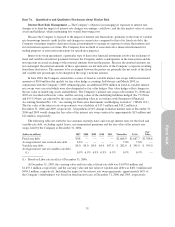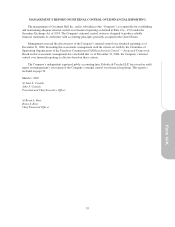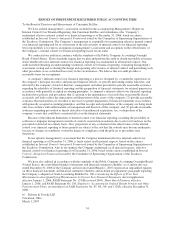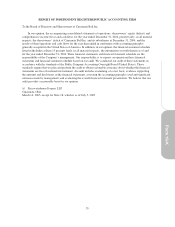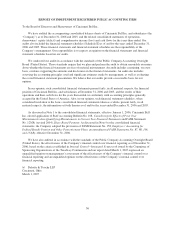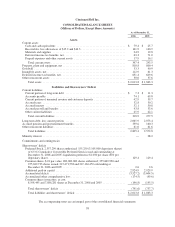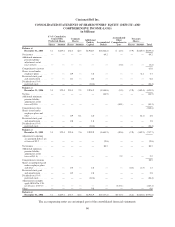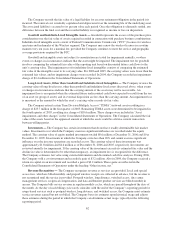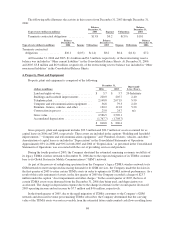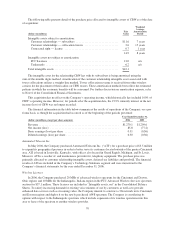Cincinnati Bell 2006 Annual Report Download - page 171
Download and view the complete annual report
Please find page 171 of the 2006 Cincinnati Bell annual report below. You can navigate through the pages in the report by either clicking on the pages listed below, or by using the keyword search tool below to find specific information within the annual report.
Notes to Consolidated Financial Statements
1. Description of Business and Significant Accounting Policies
Description of Business — Cincinnati Bell Inc. (the “Company”) provides diversified telecommunications
services through businesses in five segments: Local, Wireless, Technology Solutions (formerly referred to as
Hardware and Managed Services), Other and Broadband. In 2003, the Company sold substantially all of the
assets of the broadband business, which is reported in the Broadband segment.
The Company generates substantially all of its revenue by serving customers in the Greater Cincinnati and
Dayton, Ohio areas. An economic downturn or natural disaster occurring in this limited operating territory could
have a disproportionate effect on the Company’s business, financial condition, results of operations and cash flows
compared to similar companies of a national scope and similar companies operating in different geographic areas.
Additionally, the Company is subject to concentration risk with respect to its workforce, in that approximately
50% are party to collective bargaining agreements. A dispute or failed renegotiation of the collective bargaining
agreements could have a material adverse effect on the business.
Basis of Presentation — The consolidated financial statements of the Company have been prepared
pursuant to the rules and regulations of the Securities and Exchange Commission (“SEC”) in accordance with
accounting principles generally accepted in the United States of America. Certain prior year amounts have been
reclassified to conform to the current year classifications.
Basis of Consolidation — The consolidated financial statements include the consolidated accounts of
Cincinnati Bell Inc. and its majority-owned subsidiaries over which it exercises control. Intercompany accounts
and transactions have been eliminated in the consolidated financial statements.
Use of Estimates — Preparation of financial statements in conformity with accounting principles generally
accepted in the United States of America requires management to make estimates and assumptions that affect the
amounts reported. Actual results could differ from those estimates.
Cash Equivalents — Cash equivalents consist of short-term, highly liquid investments with original
maturities of three months or less.
Accounts Receivables — Accounts receivables consist principally of trade receivables from customers and
are generally unsecured and due within 30 days. Unbilled receivables arise from services rendered but not yet
billed. As of December 31, 2006 and 2005, unbilled receivables totaled $25.3 million and $23.1 million,
respectively. Expected credit losses related to trade receivables are recorded as an allowance for uncollectible
accounts in the Consolidated Balance Sheets. The Company establishes the allowances for uncollectible accounts
using percentages of aged accounts receivable balances to reflect the historical average of credit losses as well as
specific provisions for certain identifiable, potentially uncollectible balances. When internal collection efforts on
accounts have been exhausted, the accounts are written off by reducing the allowance for uncollectible accounts.
Materials and Supplies — Materials and supplies consist of wireless handsets, wireline network components,
various finished goods to be sold to customers, telephony inventory including maintenance inventory and inventory
in transit, and other materials and supplies, which are carried at the lower of average cost or market.
Property, Plant and Equipment — Property, plant and equipment is stated at original cost and presented
net of accumulated depreciation and impairment charges. The majority of the Local segment plant and equipment
is depreciated using the group method, which develops a depreciation rate (annually) based on the average useful
life of a specific group of assets rather than for each individual asset as would be utilized under the unit method.
The estimated life of the group changes as the composition of the group of assets and their related lives change.
Provision for depreciation of other property, other than leasehold improvements, is based on the straight-line
method over the estimated economic useful life. Depreciation of leasehold improvements is based on a straight-
line method over the lesser of the economic useful life or term of the lease, including option renewal periods if
renewal of the lease is reasonably assured.
Additions and improvements, including interest and certain labor costs incurred during a construction
period, are capitalized, while expenditures that do not enhance the asset or extend its useful life are charged to
operating expenses as incurred. Interest is capitalized on the carrying values of both wireless licenses and
equipment during the construction period of new network assets in accordance with Statement of Financial
Accounting Standards No. 34, “Capitalization of Interest Cost.” Capitalized interest for 2006, 2005, and 2004
was $1.0 million, $0.6 million, and $0.6 million, respectively.
61


